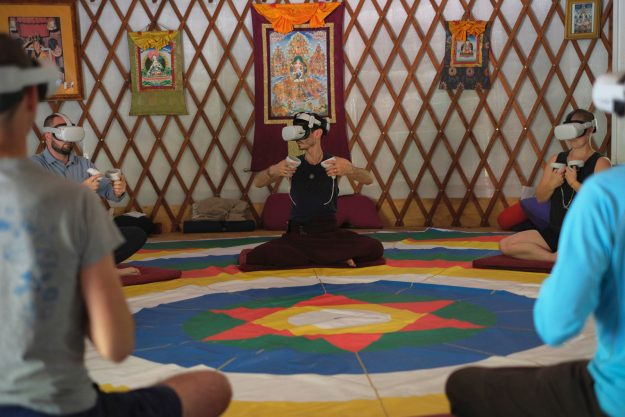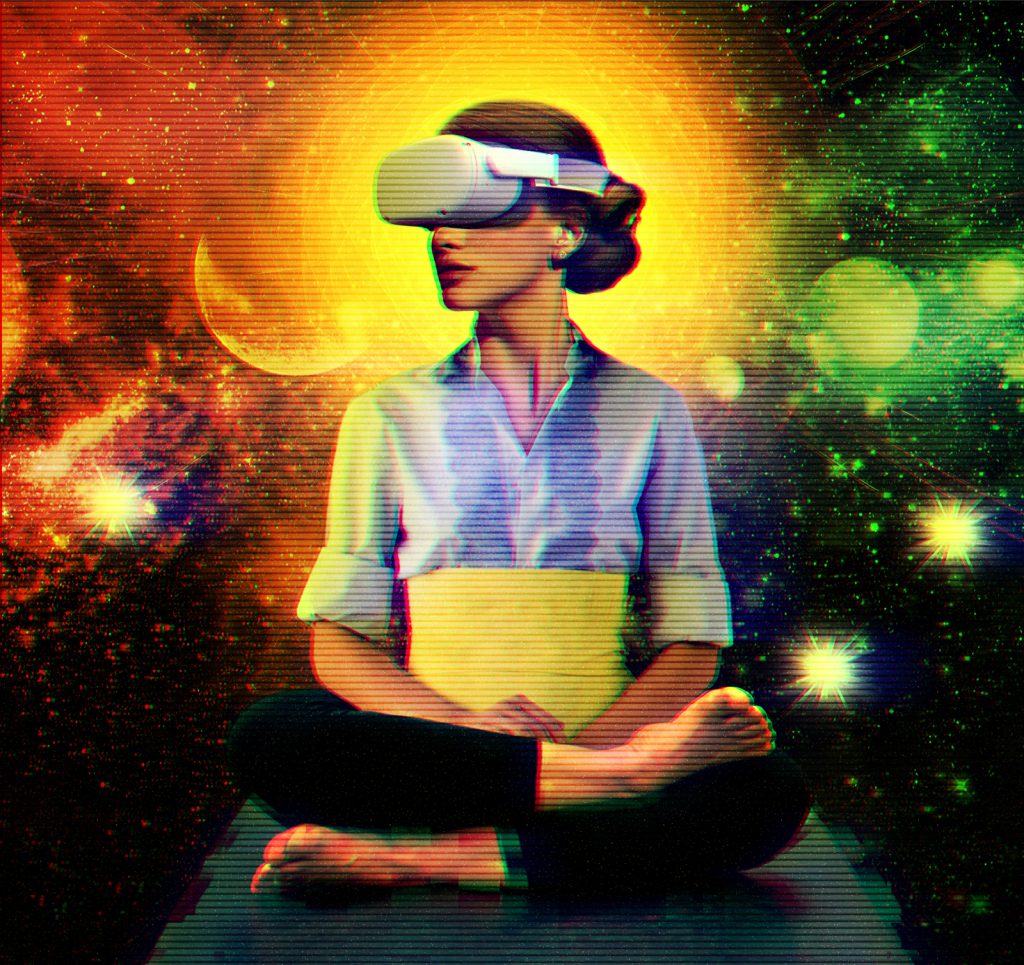All I could see was darkness —the kind that’s completely devoid of any light—and five cloud-like figures forming a circle around me. The figures weren’t shaped like human bodies, but narrow tops progressing down to more rounded middles imparted the impression they were some sort of beings. A dimly pulsing light jutted out from where I, a cloud-like being, too, appeared to be floating, arms outstretched. The light dissolved into space. I brought my arms together. Breathing in, I opened them once more. The light reappeared and floated back into the void.
This space-like environment was virtual reality, and the smoky figures were other participants, each one of them behind their own headset. Someone was in London, another in Rye, New York, and none of us knew anything about the other. We breathed in unison as we sent our lights in and out, contemplating our own heart energies and our own dissolution.
The virtual environment was designed by aNUma, a company that creates therapeutic group experiences in virtual reality (VR). I was immersed in a demonstration of aNUma’s Clear Light program, which was specifically designed to help participants contemplate and find peace with their own mortality. Unlike most VR experiences, aNUma’s aren’t an onslaught of colors and visual stimuli representing something that is believably real. In fact, they’re just the opposite.
“It’s much more minimalistic, suggestive, and spacious,” says Lama Karma, a meditation teacher who designs contemplative practices for aNUma. “We’re already living in a representational virtual bubble. What we’re seeing—other people, objects, and so forth—is seen through the filter of our habitual concepts, rather than in the immediacy of what they are. So representing reality within that reality is like a double delusion.” The aNUma environment isn’t built to represent things. It’s built to dissolve representation and help people connect with what lies beyond.
“Until we can grieve properly and address our own mortality, we can’t actually address what’s going on globally.”
Lama Karma, the spiritual director of Milarepa Retreat Center in Happy Valley, Tennessee, started working with aNUma in 2021 at the invitation of cofounder David Glowacki, who created aNUma’s space-like virtual environment and the smoky energy bodies in it. Glowacki, an artist and computational molecular physicist, had recently suffered an almost-fatal fall while hiking and was inspired by a vision of his failing body. Lying on the ground, he saw himself as a mass of light that slowly began to dim as his physical body approached death. The light wasn’t disappearing, but seeping into the world around him—carrying on. He designed a VR environment based on this near-death experience, and asked Lama Karma to create a contemplative practice for it.
With the rapid expansion in the VR space, Lama Karma was motivated by the mission of using this technology for good, for deepening embodiment, and for overcoming dualism, the exact counter to so many VR experiences. Just like all representation—written, visual, verbal—virtual reality could be a skillful means, Lama Karma thought. So, given that it’s already taking off, how do we make it beneficial rather than destructive, he asked. How do we use it to uproot clinging? After designing an experience called Ripple for aNUma, which is currently being tested for a study in Valencia, Spain, and at Northwestern University, Lama Karma developed the Clear Light program
The Clear Light pro–gram is meant for individuals facing terminal illness, their families, and their loved ones. Lama Karma has led sessions with patients at St. Joseph Home Health–Greater Sonoma County and is working with doctors at the Cedars-Sinai Pancreatic Cancer Center and the University of California, San Francisco Pancreas Center with the aim of offering the Clear Light program there too. The goal is to relieve suffering on the part of the patients and their loved ones. Right now, anyone can join the Clear Light program for free as part of a trial with Imperial College in London, and aNUma is also hosting demos for potential investors and collaborators.
Aside from the void-like atmosphere and its focus on end-of-life care, the Clear Light program differs from the more common visually stimulating VR meditative experiences by following the three noble principles of a traditional dharma practice (dampa sum). That means it starts with the motivation of bodhicitta, or the compassion-driven commitment to follow the path to awakening and be a bodhisattva. Next comes a practice that helps familiarize the practitioner with the nature of mind, or emptiness. Finally, the practice concludes with a dedication. Most participants aren’t actually Buddhist, so they might not recognize this traditional framework, but Lama Karma designed it with this in mind.
What that looks like on the ground or, rather, in real and virtual space, is a series of six sessions: an introductory call, four sessions in VR, and a concluding video call. At the start of the VR sessions, participants set an intention. They then move through a guided series of gestures and breathwork. Karma designed the heart energy sequence—wherein participants open and close their arms as light floats out and back from the body—with inspiration from a physical movement Kalu Rinpoche developed to go along with tonglen meditation, the Tibetan practice of sending and receiving. It’s a fitting foundation for an experience that, by design, helps participants feel fluid and connected to one another. The final session concludes with an offering. A central light appears in the middle of the darkness, and one at a time, participants enter it and say out loud a burden they wish to let go of. Then, participants enter the light again and invoke a benefit they’d like to receive. At the very end, the guide pairs each participant with the one with the terminal illness, and they hold each other’s hearts. The loved one names something about the dying person that they wish to steward, and the dying person names a gift they want to leave.

Though aspects of the experience could be beneficial for people to practice individually, and solo practice may become a feature one day, the Clear Light program is currently meant to be done collectively and with a guide. Lama Karma, who leads the sessions himself and is training other guides, slightly tailors sessions to respect the terminally ill patient’s needs, desires, and stage of grief. And even though participants are represented by faceless energy bodies, the sense of connection is palpable—something that surprised me when I tried the demo. Undistracted by superficial stimuli, I was able to let go of habitual judgments and open up to the individuals around me.
Lama Karma doesn’t think VR practices like this one can replace meditation without the headset, but he sees them as a good complement for experienced practitioners, or a glimpse through a window for new ones, with the potential to significantly deepen someone’s practice in a short period of time. “What this offers is a liminal experience that can initiate a seed for a new perspective,” Lama Karma told me when we spoke after my first aNUma session. Especially potent for patients with terminal illnesses who must inevitably focus so much on their physical body, the experience can help participants transcend their physical limits and connect with themselves and their loved ones as emotional and spiritual bodies too.
This boundary-opening can also benefit people who are lucky enough not to be facing or grieving over terminal illnesses, Lama Karma added. “Until we can grieve properly and address our own mortality, we can’t actually address what’s going on globally. It’s such an important starting point.”
Given the rise of AI and VR, and social media before it, our notion of truth is even more relative now, Lama Karma continues. “We’re on this precipice. For the first time, we have the capacity to represent reality so thoroughly that the crisis of meaning that we already have is going to be exacerbated exponentially.” And that’s dangerous. “‘What is real?’ isn’t just a speculative question anymore. It’s actually potentially destructive.” A paradoxical proposition for VR as most people think about it, aNUma’s Clear Light program can help people find what is real, beyond representation. “Nonconceptional wisdom is the core of everything we’re doing.”
♦
Thank you for subscribing to Tricycle! As a nonprofit, we depend on readers like you to keep Buddhist teachings and practices widely available.
